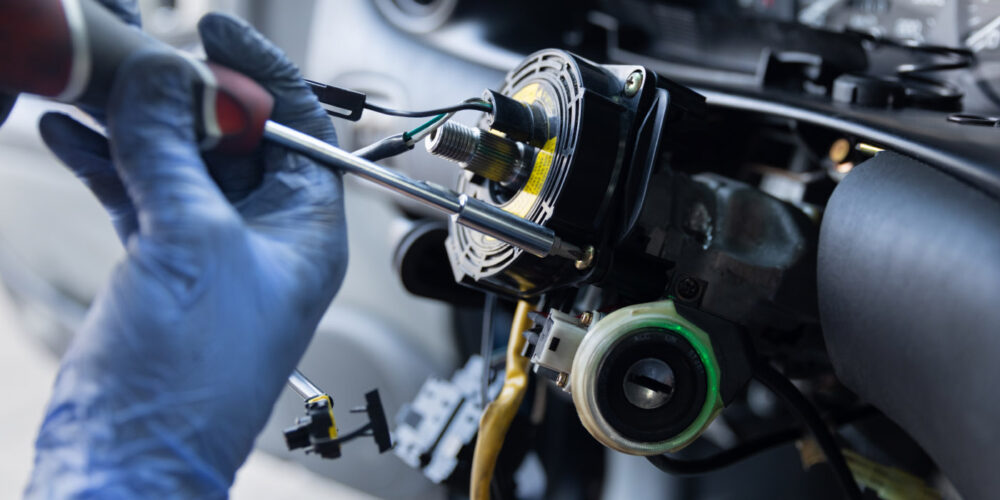Paintless dent repair has changed many repair processes for the better, yet over the years, I’ve noticed that PDR causes some friction when discussed among bodymen. I’ve seen everything from looks of awe to looks of hatred coming from repairers when the topic of PDR comes up. I’ve also heard comments such as, “They’re taking money out of my pocket” to “That’s absolutely amazing how they take those dents out with hardly any trace.”
I myself have had mixed reviews about the process.
I’ve been so frustrated when a hailstorm comes through, forcing me to spend sometimes all day writing estimate after estimate – only to have the people cash settle. Or, after these people wasted their time and ours, their insurance company would write an estimate and pay them from that estimate. And once those vehicle owners had that headache behind them, they’d go to a PDR tech to do the repair at half the estimate.
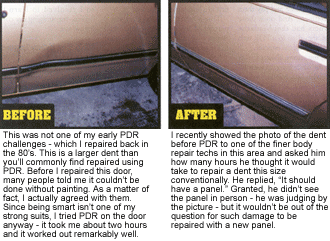
Of course, my nature always makes me look for the silver lining in such situations, and what little business sense I have makes me look for the “green” lining. I couldn’t blame these people for trying to work the system to their advantage, but I also knew that I couldn’t continue writing estimates all day for no pay at all.
Now don’t get me wrong. I enjoy visiting with practically every person who walks through our doors. But this was completely out of hand. At times, I’d have as many as five cars waiting in line for an estimate. And as much as I enjoy visiting, business has to come first in a business environment.
This is when I started charging 2 percent of the estimate to write hail claims – all of which would be applied to the repair cost if we did the repair.
Sounds simple doesn’t it? Well let me tell you, it isn’t as simple as it sounds. I’ve had wives call me up mad because their husband “paid” us for an estimate without consulting them. (I was envisioning requiring a note from their Mom the next time those guys came in.) I also found out we had special customers who the other departments wanted the estimates written for at no charge. I’d say that 99 percent of those special customers cashed settled, and then had PDR performed to their vehicles.
It was clear before long that there was no way to beat the PDR rage – so I resolved to learn the trade myself, encouraging my coworkers to follow suit.
PDR: The Urban Legend of Body Repair
I have to admit, when I was first exposed to this type of repair, I had many unanswered questions. I was certain that there had to be magic involved or something that I just couldn’t put my finger on. Or maybe these guys had made their deal at the crossroads, and they literally had hell to pay before it was all over.
I’d heard stories of these technicians using dry ice to freeze the dents out – or maybe it was lanterns to warm the metal until the dent just pops out. The versions varied, but the end result was the same: It was the stuff urban legends are made of.
It didn’t help that PDR technicians were very secretive, often hanging curtains up to block onlookers from seeing their techniques and stealing their ideas. All this secrecy only helped to fuel the negativity of many bodymen – who were skeptical of these wizards.
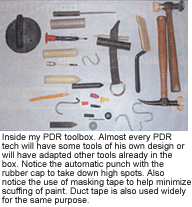
I’d jokingly ask the guys behind the curtain, “What kind of mojo are you using under there? Monkey’s foot on a stick?”
I’d sometimes get a smile, maybe a chuckle, but never would they offer to reveal the secret that I was so tactfully hinting for them to tell me. Of course, I couldn’t blame them, but by the same token, they couldn’t blame me for wanting to learn.
I Realize that PDR Isn’t a Black Art
My first attempt at PDR was a little crude because I had the misconception that there was some kind of deep, dark secret to it. I wasn’t at all ready to believe that all I had to do was to go back to the roots of metal straightening and exercise gently lifting the lows and massaging the high ridges down to their original form.
And all of this was described in detail in one of the first body repair manuals I’d ever owned. I didn’t need to go to an occult bookstore or join a Wicca group to learn PDR.
The “Fairmont Method” that was described in that body repair manual was, in essence, what I needed to give me a understanding of the steps that had to be mastered through monotonous repetition – until it all came naturally.
The Fairmont Method actually wasn’t concerned with saving paint because it was written at a time when paints were much more fragile. I remember reading about “dingers,” who were early, near-equals to today’s PDR tech. These dingers had some subtle tricks, such as taking an ice pick and sticking it through a headliner to push out a dent without leaving a noticeable trace.
PDR Training: You Get What You Pay For
Once I got a handle on the basics, I pursued some formal training. Let me tell you, there are many different levels of price and quality of PDR training. And as with anything, you get no more than you pay for.
My first formal training session had to be on the lower end of the scale as far as quality goes, but I guess that’s what we were paying for. These lessons came with any tool purchase that you made from the company we were dealing with.
I took along my assistant, Mike Bishop, to this “formal” training session in St. Louis. It didn’t take long to figure out these guys who were training us had a higher level of interest in what was in the cooler than trying to figure out which points of the art we needed to refine. (The cooler in question contained three soft drinks – one of which was diet – and the remainder of the cooler was filled with what I estimated as two cases of beer.)
Don’t get me wrong. That excursion was fun and entertaining, but we were on a mission to retrieve knowledge. Really all we got out of that session was a little confidence because the instructor told us that all we needed was practice. And as it turns out, that, my friend, is the real key. Practice.
Patience and Practice. You Need Them Both
I admit, it’s hard to exercise the patience required to learn this process. Still, I’d try to encourage the technicians who I worked with to try to incorporate these techniques into their daily routines. But many of them felt they didn’t have time to learn PDR because it slowed them down while they were learning. I, however, felt the benefits outweighed the disadvantages.
I started trying to repair dings on panels that we were going to paint anyway. In the beginning, I’d often pick the dent up to a close level, and then file it and prime it. After doing that for a while, I moved on to picking the dings up close enough to sand and prime them instead of grinding and filling them. As time went on, I was able to improve little by little – until, after considerable time, I felt reasonably proficient at PDR.
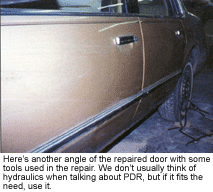
As I used PDR more and more, I became familiar with all of the different attitudes and methods used by the technicians. Many of the techniques involve drilling holes, and removing or cutting loose braces.
I now understand how these steps can make the process easier, and I’ve even tried them myself. But many organizations don’t allow such actions. I’ve seen bulletins from major carmakers as well as major insurance companies that strictly prohibit any PDR that involves drilling or cutting of any structural part.
Often, you can access these dents in areas where some PDR techs would routinely drill simply by using some slim tools that fit between braces. No drilling necessary. If that’s impossible, educate your customer and have him weigh the options. After all, it’s his vehicle. It doesn’t make sense to me to refuse to drill a small hole on some vehicles in order to save the customer often a hundred dollars on a single panel and making the repair cost effective.
If the vehicle is still under warranty or possibly a high-end vehicle, I try not to drill. But on my old truck or similar vehicles, doing a conventional repair could end up costing more than the vehicle is worth, while PDR could be economically feasible.
So Much to Choose From
Every day, you can see a number of advertisements showing new gimmicks for the PDR business. There are different reflector boards and lights to go with literally hundreds, if not thousands, of different rods, picks and tampers – all made to improve your odds of reaching every dent. You’ll even find glue sticks to help pull the dent by gluing a puller to the paint to lift the dent out. I haven’t tried such a product yet, but you never know how well it’ll work until you give it a try.
It gets confusing because there are so many companies out there making products for this type of repair that you could spend days on end searching through catalog after catalog trying to decide which product would be most beneficial for you. And tools can be expensive.
Lots people have bought a set of tools only to later find out they aren’t cut out for the business. Get a taste to see if this is for you by purchasing just a few tools. Or, you can dive right in and refinance the house for tools.
I myself bought a 25-piece pick set at a pawnshop for a mere $75, and it’s really served me well. This set obviously came from one of the many people who surely had high expectations going into this business, and it just didn’t work out.
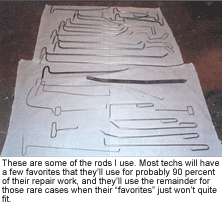
Best advice: Start off with a few relatively simple rods and an assortment of hand tools, along with a tamper of some sort to take down the highs, until you see which tools complement your “style.”
The only way you can tell what works best for you is to try some of the tools. I have a favorite “cutter” that works for me that I often reach for, yet most of the guys I work with hate that same rod.
PDR Makes You Money – and a Better Bodyman
Like any other skills, use it or loose it.
The limited time that I’m able to dedicate to this craft isn’t enough to trick myself into thinking that I can do this as well as the full timers in the trade.
That’s right. As hard as it is for me to admit, many other technicians out there can do this better than I can. On the other hand, many out there seem to have had less success with PDR even though they dedicate more time to it.
You’ll find many levels of competency in the business, and in all reality, if you understand the basics, they can help you in the everyday duties of a modern bodyman – even if you never become proficient doing PDR.
Writer Keith Combs is the body shop manager at Bill Roberts Chevrolet in Bolivar, Mo., and a GM/ASE Master Collision Repair/Refinish Technician of the Year. He’s been in the collision repair industry for 23 years.
|
PDR Basics How do you decide what dents are candidates for PDR?
You can easily repair large, soft dents like you might find on hoods and roofs. Really you can repair about any size dent with PDR as long as the metal isn’t stretched and the creases aren’t too sharp. All but the larger hail dents will usually repair with PDR, although most of the dents you’ll repair with PDR will be smaller than your hand. How do you decide if you’re the right candidate to learn PDR?
What are some common PDR mistakes?
|
Why Learn PDR?
1. It makes you a better bodyman.
After learning the basics of PDR, I noticed that almost every metal-straightening job goes smoother, and I’m able to finish the metal closer to the original contour, necessitating less filler and less work in the long run. The foundation of PDR gives you a fresh look and attitude about straightening metal. It takes away from the mindset of “grind and fill.” It even helps when you’re up against a frame repair. It’s like I’ve said before, the metal wants to go back to its original form. A bent frame is, after all, just like a heavy piece of sheet metal with creases and stress holding the damage in. In my opinion, the real foundation of PDR is relieving stress in order to allow you to bring up the lows, returning the metal back to where it remembers being before. You just have to help move it in the direction it guides you.
2. You can repair dings that were overlooked prior to painting.
One of the seemingly minor benefits to learning PDR is that you have the capabilities to repair dings that sometimes get overlooked prior to painting. Granted, we hate to mention that this happens, but occasionally it does. If PDR isn’t readily available in such an instance, we’d be facing the chore of repairing the ding in the old, conventional manner – adding days to the repair and added expense for materials (not to mention reduced customer satisfaction). Customers as well as technicians prefer a timely repair, and if a ding gets overlooked, neither the customer nor the technician will enjoy the lengthened cycle time.
3. You make extra money.
Prior to learning PDR, we really couldn’t even bid the PDR repairs. We now have the opportunity to cash in on that end of the business.
PDR especially helps during those times when hailstorms come through. At such times, “hail repair teams” will typically follow such storms, and they’ll do most of the PDR. But now I’m also able to do some hail damage repair using PDR. In the past, however, customers would swarm me with so many estimates to write that I wouldn’t have time to do any of the repairs – and they often wouldn’t want me to do the repairs because my estimate was higher then the PDR guy’s estimate. Just knowing PDR gives me the opportunity to bid the jobs using PDR, which lowers the repair cost and helps tremendously.
Another thing that happens is that word gets out that we’re bidding PDR, thus eliminating the “high estimate” for those vehicle owners who are just trying to beat the system and make a buck. This leaves us writing estimates for those who actually want us to repair their cars.
If their car is applicable for PDR, we can either do it in shop or sublet that repair if time isn’t permitting. In either case, we made some money that we wouldn’t have made before. And, if their vehicle is too damaged for PDR, then we can repair or replace the damaged panels.
I’m not the fastest PDR tech around, yet I’ve done more than $700 in hail repair before lunch on a van with more than minor hail damage.
But, because PDR is becoming more and more competitive, the price is being driven lower in some instances. When there were only a hand full of PDR technicians around, the prices were higher than they are now.
Supply and demand! When hail comes through, the demand goes up, and so do prices. When there’s no hail, I’ve seen many PDR technicians doing “used car dings” for $25 to $45 dollars a panel.





